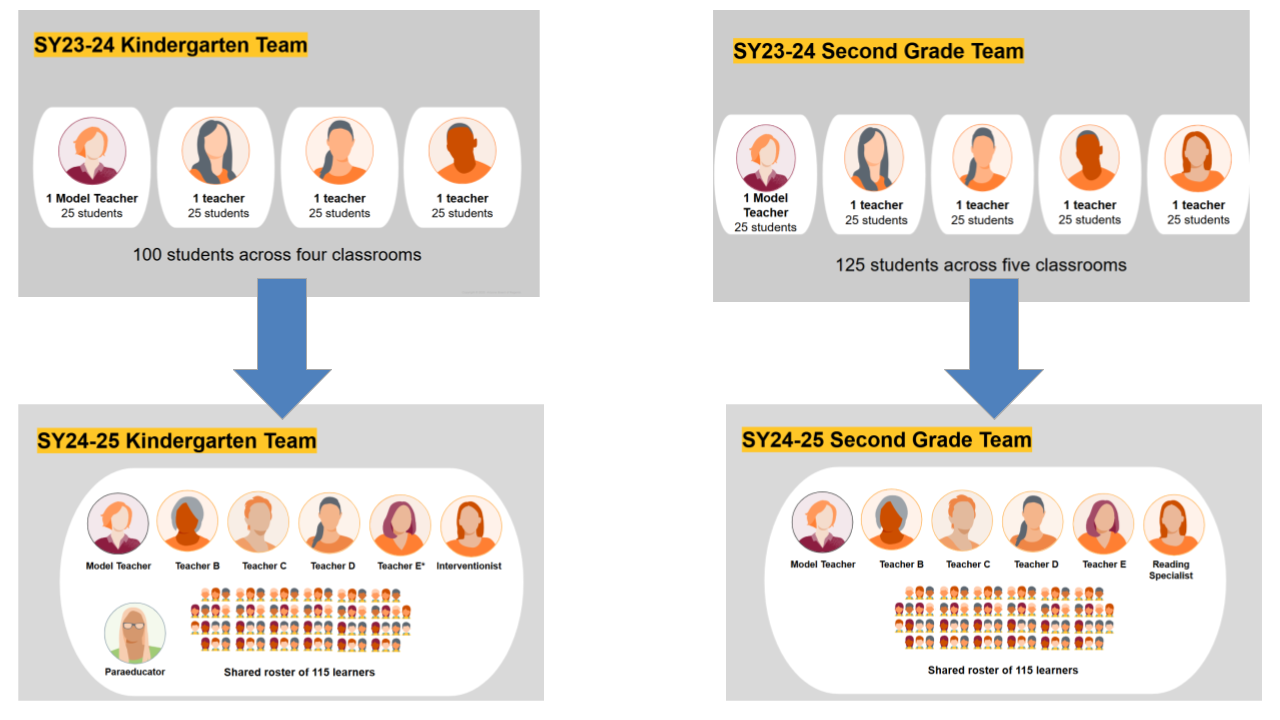The new Model Teacher program has proven to be a fully-functional structure that supports positive student experiences and stronger staff teams.
At the start of this fellowship, I shared how Detroit Academy of Arts and Sciences (DAAS) was piloting team-based strategic staffing models in our kindergarten and second-grade teams. This initiative, launched in partnership with the Michigan Education Workforce Initiative (MEWI) and Arizona State University’s Next Education Workforce, represented a bold step toward moving beyond the traditional “one teacher, one classroom” model in favor of a more sustainable, collaborative approach to teaching. My hope was that by working together in teams, educators would be greater than the sum of their parts, leading to both improved learning experiences for students and more positive working conditions for educators. In the second half of the school year, we are seeing promising early results, alongside important lessons that will shape how we can refine and scale this work moving forward.
The teaming initiative at DAAS presented us with a unique opportunity to scale our Model Teacher program as a teacher retention and professional growth strategy. In our Model Teacher program, experienced, high-performing teachers take on leadership roles, including mentoring early-career educators. By pairing Model Teacher with the teaming model, we are able to ensure that more students receive direct instruction from Model Teachers than in the traditional “one teacher, one classroom” model. This model also provides career pathways and leadership development opportunities for teachers without requiring them to leave the classroom. Artifact 1 below shows a visual representation of the evolution of the configuration of educators on the kindergarten and second grade teams at DAAS from the 2023–2024 school year to the 2024–2025 school year. Our hope is that this model will strengthen instructional quality across all classrooms by embedding mentorship and collaborative planning, and ultimately increase teacher retention as a byproduct of increased job satisfaction.

While it is still too early to look at quantitative data such as retention rates, student growth, and formal measures of teacher satisfaction, we are seeing lots of anecdotal evidence about the impact of this teaming pilot thus far. During observations with both internal DAAS staff and partners from external organizations, observers have seen exceptional levels of student independence in early grade levels, strong positive relationships between students and teachers, and a visible environment of “teachers supporting teachers.” We’re seeing evidence consistent with trends from the research shared with me by Dr. Chris Torres, Associate Professor of Education Policy and Leadership, particularly that teacher teams feel more supported and less isolated in their roles (Torres & Laski, 2024). Another benefit of this pilot is that it has significantly minimized the impact on students and staff when a teacher is absent; when one teacher on the team is out for a day, the other teachers are able to wrap around students and support the substitute teacher to ensure that routines and procedures flow smoothly, no instructional time is missed, and the student environment stays relatively consistent. The coaching and support we’ve received from our partnership with MEWI and Next Education Workforce have been invaluable in helping us reflect on how this work is going and make real-time adjustments based on coaching and feedback.
While we continue to make adjustments and iterate on the implementation of the teaming model in our pilot grades, we’re also thinking about how we can effectively evaluate the teaming model, scale for broader impact, and communicate with internal and external audiences about how this work is going. Other educator teams have gotten small glimpses of the work that is happening in second grade and kindergarten, but we are working to find more opportunities to schedule classroom observations and find time for teachers to talk with one another about the benefits and challenges of this pilot.
As we move into the second half of the school year, my focus remains on deepening our understanding of how team-based teaching can transform both student learning and teacher retention. I look forward to learning from our teachers’ experiences by gathering meaningful insights from conversations and formal feedback surveys, and sharing our journey with others who are seeking innovative solutions to educator retention.
Torres, C., & Laski, M. E. (2024, September 1). Breaking the “egg-crate” model of schooling. Educational Leadership, 82(1). https://www.ascd.org/el/articles/breaking-the-egg-crate-model-of-schooling.
